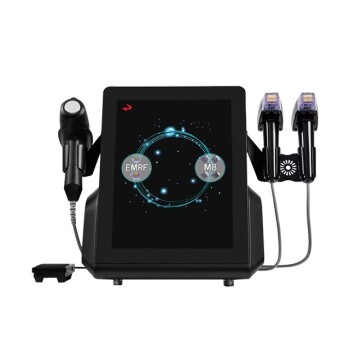At a glance, laser and IPL treatments appear nearly identical, but their underlying technology is fundamentally different. A laser produces a single, highly concentrated wavelength of light designed to target a very specific chromophore, like the melanin in a hair follicle. In contrast, Intense Pulsed Light (IPL) uses a broad spectrum of scattered, less-focused light, much like a powerful camera flash.
The core difference is precision versus versatility. Laser acts like a sniper rifle, delivering a powerful, targeted treatment for a specific goal. IPL is more like a floodlight, addressing broader, less-specific concerns with less intensity.
The Fundamental Difference: Wavelength and Focus
The type of light used in each technology directly dictates its function, effectiveness, and safety profile. Understanding this distinction is key to choosing the right treatment.
Laser: The Monochromatic Beam
A laser emits a single, coherent wavelength of light, meaning all the light particles travel together in a straight, focused line. This is known as monochromatic light.
This single-minded focus allows it to penetrate the skin to a specific, predictable depth. It is calibrated to be absorbed by a single target (like dark pigment in hair or red hemoglobin in blood vessels) while largely ignoring surrounding tissue.
IPL: The Broad Spectrum Flash
IPL devices do not produce a laser beam. Instead, they emit broad-spectrum light, which contains a wide range of different wavelengths and colors.
This light is scattered and less focused. While filters are used to narrow the spectrum for certain treatments, the energy is distributed across multiple wavelengths, hitting various structures in the skin simultaneously.
How This Impacts Real-World Treatments
The technical differences between a focused beam and a scattered flash have significant practical consequences for everything from hair removal to skin rejuvenation.
Precision and Effectiveness
Because a laser is so highly targeted, it can deliver more energy directly to the intended structure. For hair removal, this means it can more effectively destroy the hair follicle with less risk of damaging the surrounding skin.
IPL's scattered energy is less efficient at destroying a specific target. This often means that for stubborn issues like permanent hair reduction, IPL may require more sessions and may ultimately be less effective than a suitable laser.
Safety and Skin Type
This is arguably the most critical distinction. A laser's specific wavelength can be chosen to bypass the melanin in the epidermis, making certain types of lasers (like the Nd:YAG) safe for darker skin tones.
IPL's broad spectrum is more readily absorbed by all types of melanin, including that found in the skin itself. This makes IPL treatments riskier for individuals with darker skin, as the light can inadvertently heat the epidermis, leading to a higher chance of burns, blistering, or pigmentation changes.
Understanding the Trade-offs
Neither technology is universally superior; the right choice depends entirely on the problem you are trying to solve.
Laser: Power at a Cost
The primary benefits of laser are its power, precision, and safety profile across a wider range of skin tones. The trade-off is often a higher cost per session and a narrower treatment focus. A laser optimized for hair removal is not the same one used for tattoo removal.
IPL: Versatility with Limitations
IPL's main advantage is its versatility. The broad spectrum can treat multiple mild concerns at once, such as minor sun spots and general redness. However, this versatility comes with lower intensity, reduced effectiveness for specific goals, and significant limitations for use on darker skin.
Making the Right Choice for Your Goal
Your specific objective and skin type should always guide your decision. Consulting with a qualified, experienced practitioner is non-negotiable.
- If your primary focus is effective and permanent hair removal: Laser is the more precise, powerful, and predictable technology for this goal.
- If you have a darker skin tone (Fitzpatrick IV-VI): A specific type of laser is the only safe and effective light-based option for hair removal.
- If your primary focus is addressing multiple mild concerns at once (like light sun damage and general redness): IPL can be a viable, less-intensive option, provided you have a suitable lighter skin tone.
Ultimately, knowing the difference between a targeted beam and a broad flash empowers you to ask the right questions and choose the treatment best suited for your unique needs.
Summary Table:
| Feature | Laser | IPL |
|---|---|---|
| Light Type | Single, focused wavelength (monochromatic) | Broad spectrum of scattered light |
| Precision | High - like a sniper rifle | Lower - like a floodlight |
| Best For | Permanent hair removal, specific targets | Mild, multi-concern treatments |
| Safety on Darker Skin | Safer (with specific lasers like Nd:YAG) | Higher risk of burns/pigmentation |
Still unsure which technology is right for your clinic or salon?
BELIS specializes in providing professional medical aesthetic equipment, including advanced laser and IPL systems tailored for medical aesthetics clinics and premium beauty salons. Our experts can help you select the perfect device to enhance your service offerings, improve treatment outcomes, and ensure client safety.
Contact our specialists today for a personalized consultation and discover how BELIS can empower your business with the right technology.
Related Products
- Clinic Use IPL and SHR Hair Removal Machine with Nd Yag Laser Tattoo Removal
- IPL SHR+Radio frecuency machine
- RF Microneedling Machine Micro Needle Radio Frequency Machine
- Multifunctional Laser Hair Growth Machine Device for Hair Growth
- 7D 12D 4D HIFU Machine Device
People Also Ask
- Are IPL machines safe? Understanding Skin Tone Compatibility for Safe At-Home Use
- Can you see results after 1 IPL? What to Expect from Your First Treatment
- Can I use my IPL machine every week? A Guide to the Optimal At-Home Treatment Schedule
- Can you use a hair removal device on private parts? A Safe Zone Guide for Intimate Areas
- How much do IPL treatments cost? A Guide to Investing in Clear, Smooth Skin



















